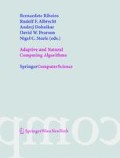Abstract
The disinfection of water supplies for domestic consumption is often achieved with the use of chlorine. Aqueous chlorine reacts with many harmful micro-organisms and other aqueous constituents when added to the water supply, which causes the chlorine concentration to decay over time. Up to a certain extent, this decay can be modelled using various decay models that have been developed over the last 50+ years. Assuming an accurate prediction of the chlorine concentration over time, a measured deviation from the values provided by such a decay model could be used as an indicator of harmful (intentional) contamination. However, most current chlorine decay models have been based on assumptions that do not allow the modelling of another species, i.e. the species with which chlorine is reacting, thereby limiting their use for modelling the effect of a contaminant on chlorine. This paper investigates the use of genetic programming as a method for developing a mixed second-order chlorine decay model.
Access this chapter
Tax calculation will be finalised at checkout
Purchases are for personal use only
Preview
Unable to display preview. Download preview PDF.
6 References
Devi Prasad T, Walters GA., and Savic D (2004) "Booster disinfection in water supply networks: A multi-objective approach", Journal of Water Resources Planning and Management ASCE, vol. 130, No.5., 2004.
Jonkergouw PMR, Khu ST, Savic D (2004) Chlorine: An indicator of intentional chemical and biological contamination in a water distribution network? AutMoNet 2004, Proceedings of: The 2nd International IWA Conference on Automation in Water Quality Monitoring, Vienna, Austria.
Feben D, Taras MJ (1951) Studies on chlorine demand constants. J. Am. Water Works Assoc., (43) 11, pp. 922–932.
Vasconcelos JJ, Rossman LA, Grayman WM, Boulos PF, Clark RM (1997) Kinetics of chlorine decay. J. Am. Waterworks. Assoc, (89) 7, pp. 55–65.
Clark RM, Sivaganesan M (2002) Predicting Chlorine Residuals in Drinking Water: Second Order Model. J. Wat. Res. Plan. Man. (128) 2, pp. 151–161.
Boccelli DL, Tryby ME, Uber JG, Summers RS (2003) A reactive species model for chlorine decay and THM formation under rechlorination conditions. Wat. Res. (37), pp. 2654–2666.
Powell JC, Hallam NB, West JR, Forster CF, Simms J (2000) Factors which control bulk chlorine decay rates. Wat. Res., (34) 1, pp. 117–126.
Shang C and Blatchley ER (2001) Chlorination of pure bacterial cultures in aqueous solution. Wat. Res. (35) 1, pp. 244–254.
Author information
Authors and Affiliations
Editor information
Editors and Affiliations
Rights and permissions
Copyright information
© 2005 Springer-Verlag/Wien
About this paper
Cite this paper
Jonkergouw, P., Keedwell, E., Khu, ST. (2005). Modelling Chlorine Decay in Water Networks with Genetic Programming. In: Ribeiro, B., Albrecht, R.F., Dobnikar, A., Pearson, D.W., Steele, N.C. (eds) Adaptive and Natural Computing Algorithms. Springer, Vienna. https://doi.org/10.1007/3-211-27389-1_49
Download citation
DOI: https://doi.org/10.1007/3-211-27389-1_49
Publisher Name: Springer, Vienna
Print ISBN: 978-3-211-24934-5
Online ISBN: 978-3-211-27389-0
eBook Packages: Computer ScienceComputer Science (R0)

